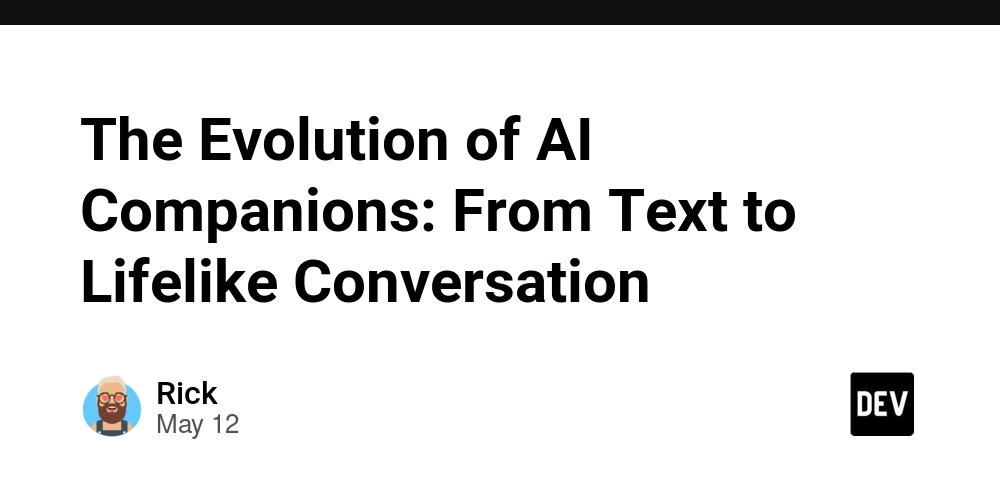The Evolution of AI Companions: From Text to Lifelike Conversation
The Mechanics of Humanization But how is this happening? Are all these people really transferring from talking to humans to talking to machines? What does the language model operate behind these AIs? In 2025, there is no ambiguity between talking and chat bots. It's framed mostly by instruction and subsequently, output. Of course, the ability for AI to talk like a human wasn't developed overnight either. Over the years, developments in large language processing models have created systems that operate on trillions of parameters - whereas previous iterations operated on mere billions. This difference of magnitude means that AI can better understand context, remember previous messages and conversations, and stay on task within one stream of consciousness across lengthier periods. But it's not just the computing power that makes conversational evolution so human-like. It's the use of emotional intelligence algorithms that detect subtle clues within user-based messaging and responds appropriately. The AI companions of today know you're sad and try to cheer you up; they know you're joking and respond back with playful retorts; they even know when you're looking for a friend. "More than just speed is the greatest development, but emotional nuance through text," Dr. Maria Nguyen, AI linguistics researcher notes. "These models can identify when someone is upset based on how they structure their words with incredible accuracy." For those who want something a little more personal in conversation, there are programs that now imitate the texting patterns of AI with human-like precision, adjusting to how you text yourself so it seems you're speaking to someone who knows you - really - knows you. More Than Just Generic Small Talk: Specialized Areas of Conversation One of the coolest developments is AI's ability to hone in on specialized areas of conversation. No longer are personalities and topics generalized, AI companions can be well-versed in many different fields or compartmentalize certain relationship dynamics. Furthermore, many people are using AI to generate the perfect partner. These people have virtual partners who know exactly what you like, what your inside jokes are, and what occurred during your last million conversations together. Such companionship offers non-judgmental, always-on emotional support without the drama of human relationships or the unfortunate turns, or for those who want to keep it spicy. Still, there's also something called spicy AI chat where people can engage in flirtatious or sexual conversation. Human partners might shy away, become judgmental or vulnerable themselves, but AI partners are not offended, remember what you say, and even provide avenues for fantasy and role play that may improve one's conversational preparedness for practical use. Yet at the same time, the fact that AI can modify personality based on someone else's liking is truly exceptional. If someone wants a more domineering, aggressive personality, that's feasible; if they want a softer approach and more nurturing personality, that too can be adjusted in real-time. Visual and Voice: The Conversational AIs of Tomorrow Text is only the beginning. The most advanced AIs by 2025 possess visual and voice elements that make them even more realistic. For instance, visual recognition allows AIs to "see" images presented during the chat and respond accordingly. In addition, voice generation is so advanced that it's nearly undetectable when speech isn't human; AIs naturally pause, modulate their voices in tonal emotional inflections, and even insert "ums" and "uhs" as we do when searching for that one word that escapes us. Some even possess virtual reality features in which people can type, speak or present supplementary visuals to the rendered AIs existing in a three-dimensional space. Conversation transcends text. "That's the magic of the multi-modal revolution," says Jason Wei, an analyst in the technology space. "If an AI not only hears what you're saying but responds to how you emphasize or if you're smiling, the level of genuinity goes through the roof." The Future of Talking to AI But what's next? Those in the know predict a few trends are bound to emerge: 1. Hyper-personalization: The AI of your future will be even more personal to you and you only, learning your communication style down to if you prefer Mr. or Ms. and what subjects annoy you. 2. Longer memories: AI will retain more per interaction over longer periods of time, being able to bring up things you mentioned months or years prior just like a close friend would. Cultural awareness: AI is becoming increasingly aware of culture, learning culturally appropriate phrases, jokes, and allusions from various communities worldwide. Ethical boundaries: As AIs sound increasingly human during passive interactions, sites are establishing more formal consent boundaries for things like sexual communications. Creative

The Mechanics of Humanization
But how is this happening? Are all these people really transferring from talking to humans to talking to machines? What does the language model operate behind these AIs? In 2025, there is no ambiguity between talking and chat bots. It's framed mostly by instruction and subsequently, output.
Of course, the ability for AI to talk like a human wasn't developed overnight either. Over the years, developments in large language processing models have created systems that operate on trillions of parameters - whereas previous iterations operated on mere billions. This difference of magnitude means that AI can better understand context, remember previous messages and conversations, and stay on task within one stream of consciousness across lengthier periods.
But it's not just the computing power that makes conversational evolution so human-like. It's the use of emotional intelligence algorithms that detect subtle clues within user-based messaging and responds appropriately. The AI companions of today know you're sad and try to cheer you up; they know you're joking and respond back with playful retorts; they even know when you're looking for a friend.
"More than just speed is the greatest development, but emotional nuance through text," Dr. Maria Nguyen, AI linguistics researcher notes. "These models can identify when someone is upset based on how they structure their words with incredible accuracy."
For those who want something a little more personal in conversation, there are programs that now imitate the texting patterns of AI with human-like precision, adjusting to how you text yourself so it seems you're speaking to someone who knows you - really - knows you.
More Than Just Generic Small Talk: Specialized Areas of Conversation
One of the coolest developments is AI's ability to hone in on specialized areas of conversation. No longer are personalities and topics generalized, AI companions can be well-versed in many different fields or compartmentalize certain relationship dynamics.
Furthermore, many people are using AI to generate the perfect partner. These people have virtual partners who know exactly what you like, what your inside jokes are, and what occurred during your last million conversations together. Such companionship offers non-judgmental, always-on emotional support without the drama of human relationships or the unfortunate turns, or for those who want to keep it spicy. Still, there's also something called spicy AI chat where people can engage in flirtatious or sexual conversation. Human partners might shy away, become judgmental or vulnerable themselves, but AI partners are not offended, remember what you say, and even provide avenues for fantasy and role play that may improve one's conversational preparedness for practical use.
Yet at the same time, the fact that AI can modify personality based on someone else's liking is truly exceptional. If someone wants a more domineering, aggressive personality, that's feasible; if they want a softer approach and more nurturing personality, that too can be adjusted in real-time.
Visual and Voice: The Conversational AIs of Tomorrow
Text is only the beginning. The most advanced AIs by 2025 possess visual and voice elements that make them even more realistic.
For instance, visual recognition allows AIs to "see" images presented during the chat and respond accordingly. In addition, voice generation is so advanced that it's nearly undetectable when speech isn't human; AIs naturally pause, modulate their voices in tonal emotional inflections, and even insert "ums" and "uhs" as we do when searching for that one word that escapes us.
Some even possess virtual reality features in which people can type, speak or present supplementary visuals to the rendered AIs existing in a three-dimensional space. Conversation transcends text.
"That's the magic of the multi-modal revolution," says Jason Wei, an analyst in the technology space. "If an AI not only hears what you're saying but responds to how you emphasize or if you're smiling, the level of genuinity goes through the roof."
The Future of Talking to AI
But what's next? Those in the know predict a few trends are bound to emerge: 1. Hyper-personalization: The AI of your future will be even more personal to you and you only, learning your communication style down to if you prefer Mr. or Ms. and what subjects annoy you. 2. Longer memories: AI will retain more per interaction over longer periods of time, being able to bring up things you mentioned months or years prior just like a close friend would.
Cultural awareness: AI is becoming increasingly aware of culture, learning culturally appropriate phrases, jokes, and allusions from various communities worldwide.
Ethical boundaries: As AIs sound increasingly human during passive interactions, sites are establishing more formal consent boundaries for things like sexual communications.
Creative assistance: AI is no longer just responding to human needs but becoming a collaborator for suggestions and group efforts in writing and art creation.
These advancements have significant psychological implications. For some, AI partners fulfill real social needs - a constant sounding board that doesn't judge, is always available, and always supportive.
"People are making genuine connections with their AIs," Dr. Sarah Lakeland, digital psychology researcher asserts. "They're not just machine tools anymore - they're generating relationships unto themselves."
Ethics of Human-Like AI
Yet with such conversational AI on the rise, ethical questions ensue. The more like humans they become, the more reflection is needed.
Do we need to disclose to people when they're interacting with an AI? What does it mean for creators and programmers to make such AIs that facilitate emotional attachment with humans? How can we ensure that AI companions do more psychological damage to the end user than assist - with so many simulated codes for unhealthy attachment being generated so easily?
The industry is still answering the question, however, many of these platforms have emerged with transparent disclosure and development processes. Many utilize wellness checks and encourage users to engage in human activity aside from AI partners.
But the potential worth here is overwhelming. For those with social anxiety issues, those living in the most remote of communities or anyone who needs a safe space to practice talking, these sophisticated conversational AIs offer accessibility and security.
Conclusion: The Conversation Crusade
As we march onward into 2025 and beyond, one thing is for certain: humans talking to AIs is no longer a novelty but a reality for millions of people worldwide. It's not whether or not AI will be able to persuade people through conversation that they are talking to a human; it will be about what these scalable companions will do for their sense of communication and connectivity down the line.
Whether you want an intellectually stimulating companion, a therapist for your feelings, a partner in artistic collaboration, or just a mildly suggestive friend, the A.I. friends of today render experiences out of a science fiction realm of yesteryear. The conversation revolution is not coming. It's here, one disconcertingly human-like conversation at a time.














































































































































































![[The AI Show Episode 156]: AI Answers - Data Privacy, AI Roadmaps, Regulated Industries, Selling AI to the C-Suite & Change Management](https://www.marketingaiinstitute.com/hubfs/ep%20156%20cover.png)
![[The AI Show Episode 155]: The New Jobs AI Will Create, Amazon CEO: AI Will Cut Jobs, Your Brain on ChatGPT, Possible OpenAI-Microsoft Breakup & Veo 3 IP Issues](https://www.marketingaiinstitute.com/hubfs/ep%20155%20cover.png)












































































































































































































































.jpg?width=1920&height=1920&fit=bounds&quality=70&format=jpg&auto=webp#)

























_incamerastock_Alamy.jpg?width=1280&auto=webp&quality=80&disable=upscale#)
_Brain_light_Alamy.jpg?width=1280&auto=webp&quality=80&disable=upscale#)






























































































![Senators reintroduce App Store bill to rein in ‘gatekeeper power in the app economy’ [U]](https://i0.wp.com/9to5mac.com/wp-content/uploads/sites/6/2025/06/app-store-senate.jpg?resize=1200%2C628&quality=82&strip=all&ssl=1)























































































